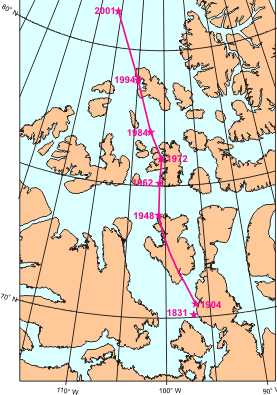[/caption]
The Earth has a magnetic field, known as the magnetosphere, that protects our planet from the particles of the solar winds. One point of that field is known as the Magnetic North Pole. The Magnetic North Pole is not the geographic North Pole; it is actually hundreds of miles south of the geographic North Pole and north of Canada.
Hundreds of years ago, European navigators believed that the needles of compasses were attracted to some “magnetic mountain” or “island” thought to be located in the far north. Some also believed that the needles could be attracted to the Pole Star, which is part of the Ursa Minor constellation and has long been used in navigation. One English philosopher, William Gilbert, proposed that the Earth acts like a giant magnet; he also was the first person to state that the Earth’s magnetic field points vertically downward at the Magnetic North Pole. It took hundreds of years before scientists came to properly understand our planet’s magnetic field, although this is known to be correct now.
All magnets have two poles, like the “plus” and “minus” signs found on batteries. Instead of these locations being named plus and minus though, they were named the North and South Magnetic Poles. It is toward the Magnetic North Pole that your compass points not the geographic North Pole, which makes sense considering it utilizes magnets to determine direction. At the Magnetic North Pole, the magnetic fields points down vertically; in other words it has a 90° “dip” toward the Earth’s surface. The counterpart of the Magnetic North Pole is the Magnetic South Pole. Because the Earth’s magnetic field is not perfectly symmetrical, the magnetic fields are not antipodal. That means that if you draw a straight line between them, it does not pass through the Earth’s center. It is off by approximately 530 km. The North and South Magnetic Poles are also known as Magnetic Dip Poles because they “dip” at a 90° angle towards the Earth.
The Magnetic North Pole continues to move around. According to the Geological Survey of Canada, which routinely studies the Magnetic North Pole, the pole moves as much as 40 km per year. It also moves daily. Every day, the Magnetic North Pole has an elliptical movement of approximately 80 km from the average point of its center. That means when you are using a compass, you have to be aware of the difference between magnetic north and geographic north.
Universe Today has articles on Earth’s magnetic field and modeling the Earth’s magnetic field.
For more information, check out the Magnetic North Pole and geomagnetism.
Astronomy Cast has an episode on Earth.
References:
Earth’s Inconstant Magnetic Field
Earth’s Magnetic Field and its Changes in Time

